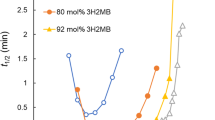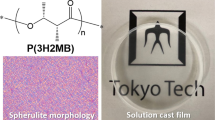Abstract
We investigated the biosynthesis and properties of poly(3-hydroxybutyrate-co-3-hydroxyvalerate) (PHBV) produced by Haloferax mediterranei NBRC14739T from glucose. When H. mediterranei grew on 5 g/L glucose in flask culture, 43.7 wt% PHBV with 12 mol% 3-hydroxyvalerate (3HV) accumulated intracellularly. Size-exclusion chromatography revealed that this polymer had a weight-average molecular weight (Mw) and polydispersity (Mw/Mn) of 4.7 × 106 g/mol and 1.7, respectively. Increasing the glucose concentration in the flask cultures slightly promoted cell growth and increased the PHBV content but had less effect on molecular weight. Scale-up cultivation in a 5-L jar yielded 4.0 g/L PHBV from 20 g/L glucose with a Mw of up to 5.0 × 106 g/mol. These results showed that H. mediterranei can produce ultrahigh-molecular-weight (UHMW) PHBV from glucose. UHMW-PHBV (7 mol% 3HV, Mw = 4.4 × 106 g/mol) was used to prepare cold-drawn films, the mechanical properties of which were characterized. The films were produced by tenfold cold drawing, followed by annealing at 100 °C, and had a tensile strength and Young’s modulus of 258.7 MPa and 0.90 GPa, respectively.
This is a preview of subscription content, access via your institution
Access options
Subscribe to this journal
Receive 12 print issues and online access
$259.00 per year
only $21.58 per issue
Buy this article
- Purchase on Springer Link
- Instant access to full article PDF
Prices may be subject to local taxes which are calculated during checkout




Similar content being viewed by others
References
Sudesh K, Abe H, Doi Y. Synthesis, structure, and properties of polyhydroxyalkanoates: biological polyesters. Prog Polym Sci. 2000;25:1503–55.
Jendroseek D, Pfeiffer D. New insights in the formation of polyhydroxyalkanoate granules (carbonosomes) and novel functions of poly(3-hydroxybutyrate). Environ Microbiol. 2014;16:2357–73.
Sperling S, Knupffer E, Behnsen H, Mudersbach M, Krieg H, Springer S, et al. Bio-based plastics—a review of environmental, social and economic impact assessments. J Clean Prod. 2018;185:476–91.
Ng EL, Lwanga EH, Eldridge SM, Johnston P, Hu HW, Gessen V, et al. An overview of microplastic and nanoplastic pollution in agroecosystems. Sci Total Environ. 2018;627:1377–88.
Kusaka S, Iwata T, Doi Y. Microbial synthesis and physical properties of ultra-high-molecular-weight poly[(R)-3-hydroxybutyrate]. J Macromol Sci Pure Appl Chem A. 1998;35:319–35.
Kusaka S, Abe H, Lee SY, Doi Y. Molecular mass of poly[(R)-3-hydroxybutyric acid] produced in a recombinant Escherichia coli. Appl Microbiol Biotechnol. 1997;47:140–3.
Sim SJ, Snell KD, Hogan SA, Stubbe J, Rah C, Siskey AJ. PHA synthase activity controls the molecular weight and polydispersity of polyhydroxybutyrate in vivo. Nat Biotechnol. 1997;15:63–7.
Kahar P, Agus J, Kikkawa Y, Taguchi K, Doi Y, Tsuge T. Effective production and kinetic characterization of ultra-high-molecular-weight poly[(R)-3-hydroxybutyrate] in recombinant Escherichia coli. Polym Degrad Stab. 2005;87:161–9.
Iwata T. Strong fibers and films of microbial polyesters. Macromol Biosci. 2005;5:689–701.
Aoyagi Y, Doi Y, Iwata T. Mechanical properties and highly ordered structure of ultra-high-molecular-weight poly[(R)-3-hydroxybutyrate] films: effects of annealing and two-step drawing. Polym Degrad Stab. 2003;79:209–16.
Hiroe A, Tsuge K, Nomura CT, Itaya M, Tsuge T. Rearrangement of gene order in the phaCAB operon leads to effective production of ultrahigh-molecular-weight poly[(R)-3-hydroxybutyrate] in genetically engineered Escherichia coli. Appl Environ Microbiol. 2012;78:3177–84.
Agus J, Kahar P, Abe H, Doi Y, Tsuge T. Molecular weight characterization of poly[(R)-3-hydroxybutyrate] synthesized by genetically engineered strains of Escherichia coli. Polym Degrad Stab. 2006;91:1138–46.
Castillo T, Flores C, Segura D, Espin G, Sanguino J, Cabrera E, et al. Production of polyhydroxybutyrate (PHB) of high and ultra-high molecular weight by Azotobacter vinelandii in batch and fed-batch cultures. J Chem Technol Biotechnol. 2017;92:1809–16.
Arikawa H, Sato S, Fujiki T, Matsumoto K. A study on the relation between poly(3-hydroxybutyrtae) depolymerases of oligomer hydrolases and molecular weight of polyhydroxyalkanoates accumulating in Cupriavidus necator H16. J Biotechnol. 2016;227:94–102.
Tsuge T, Watanabe S, Shimada D, Abe H, Doi Y, Taguchi S. Combination of N149S and D171G mutations in Aeromonas caviae polyhydroxyalkanoate synthase and impact on polyhydroxyalkanoate biosynthesis. FEMS Micobiol Lett. 2007;277:216–22.
Rodorigez-Valera F, Ruiz-Berraquero F, Ramos-Cormenzana A. Isolation of extremely halophilic bacteria able to grow in defined inorganic media with single carbon sources. J Gen Microbiol. 1980;119:535–8.
Fernandez-Castillo R, Rodorigez-Valera F, Gonzalez-Ramos J, Ruiz-Berraquero F. Accumulation of poly(β-hydroxybutyrate) by halobacteria. Appl Environ Microbiol. 1986;51:214–6.
Rodrigeuez-Valera F, Lillo JAG. Halobacteria as producers of polyhydroxyalkanoates. FEMS Microbiol Rev. 1992;103:181–6.
Lillo JG, Rodorigez-Valera F. Effects of culture conditions on poly(β-hydroxybutyric acid) production by Haloferax mediterranei. Appl Environ Microbiol. 1990;56:2517–21.
Lu Q, Han J, Zhou L, Zhou J, Xiang H. Genetic and biochemical characterization of the poly(3-hydroxybutyrate-co-3-hydroxyvalerate) synthase in Haloferax mediterranei. J Bacteriol. 2008;190:4173–80.
Han J, Zhang F, Hou J, Liu X, Li M, Liu H, et al. Complete genome sequence of the metabolically versatile halophilic archaeon Haloferax mediterranei, a poly(3-hydroxybutyrate-co-3-hydroxyvalerate) producer. J Bacteriol. 2012;194:4463–4.
Han J, Hou J, Zhang F, AiG LiM, Cai S, Liu H, et al. Multiple propionyl coenzyme A-supplying pathways for production of the bioplastic poly(3-hydroxybutyrate-co-3-hydroxyvalerate) in Haloferax mediterranei. Appl Environ Microbiol. 2013;79:2922–31.
Ferre-Guell A, Winterburn J. Biosynthesis and characterization of polyhydroxyalkanoates with controlled composition and microstructure. Biomacromolecules. 2018;19:996–1005.
Fukui T, Doi Y. Cloning and analysis of the poly(3-hydroxybutyrate-co-3-hydroxyhexanoate) biosynthesis genes of Aeromonas caviae. J Bacteriol. 1998;179:4821–30.
Kato M, Bao HJ, Kang CJ, Fukui T, Doi Y. Production of a novel copolyester of 3-hydroxybutyric acid and medium-chain-length 3-hydroxyalkanoic acids by Pseudomonas sp. 61-3 from sugars. Appl Microbiol Biotechnol. 1996;45:363–70.
Iwata T, Tsunoda K, Aoyagi Y, Kusaka S, Yonezawa N, Doi Y. Mechanical properties of uniaxially cold-drawn films of poly([R]-3-hydroxybutyrate). Polym Degrad Stab. 2003;79:217–24.
Han J, Wu LP, Hou J, Zhao D, Xiang H. Biosynthesis, characterization, and hemostasis potential of tailor-made poly(3-hydroxybutyrate-co-3-hydroxyvalerate) produced by Haloferax mediterrnaei. Biomacromolecules. 2015;16:578–88.
Koller M, Hesse P, Bona R, Kutschera C, Atlić A, Braunegg G. Potential of various archae- and eubacterial strains as industrial polyhydroxyalkanote producers form whey. Macromol Biosci. 2007;7:218–26.
Don TM, Chen CW, Chan TH. Preparation and characterization of poly(hydroxyalkanoate) from the fermentation of Haloferax mediterranei. J Biomater Sci Polym Ed. 2006;17:1425–38.
Tsuge T. Fundamental factors determining the molecular weight of polyhydroxyalkanoate during biosynthesis. Polym J. 2016;48:1051–7.
Han J, Li M, Hou J, Wu L, Zhou J, Xiang H. Comparison of four phaC genes from Haloferax mediterranei and their function in different PHBV copolymer biosynthesis in Haloarcula hispanica. Saline Syst. 2010;6:9.
Avella M, La Rota G, Martuscelli E, Raimo M. Poly(3-ydroxyburytae-co-3-hydroxyvalerate) and wheat straw fiber composites: thermal, mechanical properties and biodegradation behavior. J Mater Sci. 2000;35:829–36.
Iwata T, Doi Y. Mechanical properties of uniaxially cold-drawn films of poly[(R)-3-hydroxybutyrate] and its copolymers. Macromol Symp. 2005;224:11–9.
Aoyagi Y, Yamashita K, Doi Y. Thermal degradation of poly[(R)-3-hydroxybutyrate], poly[ε-caprolactone], and poly[(S)-lactide]. Polym Degrad Stab. 2002;76:53–9.
Acknowledgements
The authors greatly appreciate technical assistance from Ms. Hiroko Shinozaki.
Author information
Authors and Affiliations
Corresponding author
Ethics declarations
Conflict of interest
The authors declare that they have no conflict of interest.
Additional information
Publisher’s note Springer Nature remains neutral with regard to jurisdictional claims in published maps and institutional affiliations.
Rights and permissions
About this article
Cite this article
Ino, K., Sato, S., Ushimaru, K. et al. Mechanical properties of cold-drawn films of ultrahigh-molecular-weight poly(3-hydroxybutyrate-co-3-hydroxyvalerate) produced by Haloferax mediterranei. Polym J 52, 1299–1306 (2020). https://doi.org/10.1038/s41428-020-0379-9
Received:
Revised:
Accepted:
Published:
Issue Date:
DOI: https://doi.org/10.1038/s41428-020-0379-9
This article is cited by
-
Exploitation of Biomass to the Integrated Production of Bioethanol and Poly(hydroxyalkanoate)s
BioEnergy Research (2023)
-
Evaluating haloarchaeal culture media for ultrahigh-molecular-weight polyhydroxyalkanoate biosynthesis by Haloferax mediterranei
Applied Microbiology and Biotechnology (2021)



